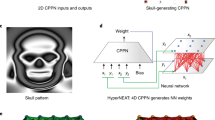Abstract
The relationship between biology and economics has been long: it is said that 150 years ago both Wallace and Darwin were influenced by Malthus’ writings on the rising pressures on people in a world in which human population numbers grew geometrically while food production only grew arithmetically. In the early 1950s there was an awakening that the processes of market competition in a sense mimicked those of natural selection. This thread has followed through to the present, in an “evolutionary” approach to industrial organization. Recently, however, computer scientists and economists have begun to apply principles borrowed from biology to a variety of complex problems in optimization and in modelling the adaptation and change that occurs in real-world economic problems.
The first author wishes to acknowledge the support of the Australian Research Council.
Access this chapter
Tax calculation will be finalised at checkout
Purchases are for personal use only
Preview
Unable to display preview. Download preview PDF.
Similar content being viewed by others
References
Adeli, H., & Hung S.-L.: 1995, Machine Learning: Neural Networks, Genetic Algorithms, and Fuzzy Systems. NY: Wiley.
Axelrod, R.: 1984, The Evolution of Cooperation. New York: Basic Books.
Axelrod, R.: 1987, ‘The evolution of strategies in the iterated Prisoner’s Dilemma’. In: L. Davis (ed.), Genetic Algorithms and Simulated Annealing, London: Pitman, pp. 32–41.
Bertsekas, D.P., Tsitsiklis, J.N.: 1996, Neuro-Dynamic Programming. Athena Scientific: Athena Scientific.
Bethke, A.D.: 1981, ‘Genetic algorithms as function optimizers’. (Doctoral dissertation, University of Michigan), Dissertation Abstracts International 41(9): 3,503B. (University Microfilms No. 81–06,101).
Brady, R.M.: 1985, ‘Optimization strategies gleaned from biological evolution’. Nature 317, 804–806.
Cho, I.-K.: 1995, ‘Perceptrons play the repeated Prisoner’s Dilemma’. Journal of Economic Theory 67,266–284.
Davis, L.: 1991, ‘A genetic algorithms tutorial’. In: Davis L. (ed.), Handbook of Genetic Algorithms, New York: Van Nostrand Reinhold.
Dupré, J. (ed.): 1987, The Latest on the Best: Essays on Evolution and Optimality. Cambridge: MIT Press.
Fogel, D.B, Harrald, P.G.: 1994, ‘Evolving continuous behaviors in the iterated Prisoner’s Dilemma’. In: Sebald, A., Fogel, L. (eds.), The Third Annual Conference on Evolutionary Programming, Singapore: World Scientific, pp. 119–130.
Fujiki, C., Dickinson, J.: 1987, ‘Using the genetic algorithm to generate Lisp source code to solve the Prisoner’s Dilemma’. In: Grefenstette J.J. (ed.), Genetic Algorithms and their Applications, Proceedings of the 2nd. International Conference on Genetic Algorithms, Hillsdale, N.J.: Lawrence Erlbaum, pp. 236–240.
Goldberg, D.E.: 1989, Genetic Algorithms in Search, Optimization and Machine Learning. Reading, Mass.: Addison-Wesley.
Gould S.J.: 1996, Full House: The Spread of Excellence from Plato to Darwin. New York: Harmony Books.
Grefenstette, J.J.: 1987, ‘A User’s Guide to GENESIS’. Navy Center for Application Research in Artificial Intelligence, Naval Research Laboratories, mimeo., Washington D.C..
Hebb, D.: 1949, The Organization of Behavior. New York: Wiley.
Holland, J.H.: 1975, Adaptation in Natural and Artificial Systems. Ann Arbor: Univ. of Michigan Press.
Holland, J.H.: 1984, ‘Genetic algorithms and adaptation’. In: Selfridge O., Rissland E., & Arbib M.A. (eds.), Adaptive Control of Ill-Defined Systems, New York: Plenum.
Koza, J.R.: 1992, Genetic Programming. Cambridge: MIT Press.
Klos, T.B.: 1997, ‘Spacially coevolving automata play the Repeated Prisoner’s Dilemma’. In: Conte, R., Hegselmann, R. and P. Terna (eds.), Simulating Social Phenomena, Berlin: Springer, pp. 153–159.
Langton, C.G., Taylor, C., Farmer, J.D., Rasmussen, S. (ed.): 1992, Artificial Life II. Reading: Addison-Wesley.
Marks, R.E.: 1989, ‘Niche strategies: the Prisoner’s Dilemma computer tournaments revisited’. AGSM Working Paper 89–009, http://www.agsm.unsw.edu.au/bobm/papers/niche.pdf.
Marks, R.E.: 1992a, ‘Breeding optimal strategies: optimal behaviour for oligopolists’. Journal of Evolutionary Economics 2, 17–38.
Marks, R.E.: 1992b, ‘Repeated games and finite automata’. In: Creedy, J., Borland, J., Eichberger, J. (eds.), Recent Developments in Game Theory, Aldershot: Edward Elgar.
McCulloch, W.S., Pitts, W.: 1943, ‘A logical calculus of the ideas immanent in nervous activity’. Bulletin of Mathematical Biophysics 5,.: Berlin, Michalewicz, Z.. Springer, 2nd ed: Genetic Algorithms+Data Structures = Evolutionary Programs.1994
Miller, J.H.: 1996, ‘The coevolution of automata in the repeated Prisoner’s Dilemma’. Journal of Economic Behavior and Organization 29, 87–112.
Minsky, M., Papert, S.: 1969, Perceptrons. Cambridge: MIT Press.
Mitchell, M.: 1996, An Introduction to Genetic Algorithms. Cambridge: MIT Press.
Nissen, V.: 1995, ‘An overview of evolutionary algorithms in management applications’. In: J. Biethahn & V. Nissen (eds.), Evolutionary Algorithms in Management Applications, Berlin: Springer, pp. 44–97.
Nissen, V., Biethahn, J.: 1995, ‘An introduction to evolutionary algorithms’. In: J. Biethahn & V. Nissen (eds.), Evolutionary Algorithms in Management Applications, Berlin: Springer, pp. 3–43.
Rechenberg, I.: 1973, Evolutionsstrategie. Optimierung technischer Systeme nach Prinzipien der biologischen Evolution. Stuttgart: Frommann-Holtzboog.
Rumelhart, D.E., McClelland, J.L..: 1986, Parallel Distributed Processing: Explorations in the Microstructure of Cognition, Vol.]: Foundation, 2. Aufl.. Cambridge: MIT Press.
Sargent, T.J.: 1993, Bounded Rationality in Macroeconomics. Oxford: O.U.P..
Schaffer, J.D., Grefenstette, J.J.: 1988, ‘A critical review of genetic algorithms’. Mimeo.
Schwefel, H.P., Manner, R.: 1991, Parallel Problem Solving from Nature,(Lecture Notes in Computer Science 496). Berlin: Springer.
Sebald, A., Fogel, L. (eds.): 1994, The Third Annual Conference on Evolutionary Programming. Singapore: World Scientific.
White, H.:1992, Artificial Neural Networks: Approximation and Learning. Oxford: Basil Blackwell.
Widrow, B., Hoff, M.E.: 1960, ‘Adaptive switching circuits’. Institute of Radio Engineers,Western Electronic Show and Convention, Convention Record 4, 96–104.
Editor information
Editors and Affiliations
Rights and permissions
Copyright information
© 1999 Springer Science+Business Media New York
About this chapter
Cite this chapter
Marks, R.E., Schnabl, H. (1999). Genetic Algorithms and Neural Networks: A Comparison Based on the Repeated Prisoners Dilemma. In: Brenner, T. (eds) Computational Techniques for Modelling Learning in Economics. Advances in Computational Economics, vol 11. Springer, Boston, MA. https://doi.org/10.1007/978-1-4615-5029-7_8
Download citation
DOI: https://doi.org/10.1007/978-1-4615-5029-7_8
Publisher Name: Springer, Boston, MA
Print ISBN: 978-1-4613-7285-1
Online ISBN: 978-1-4615-5029-7
eBook Packages: Springer Book Archive




